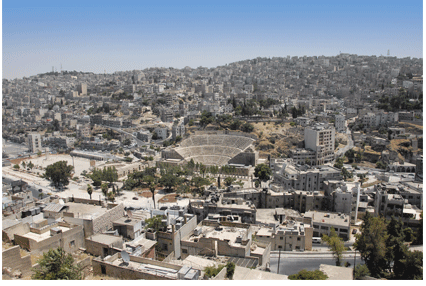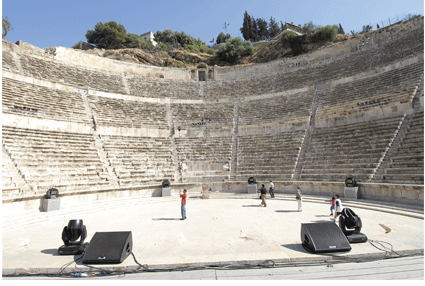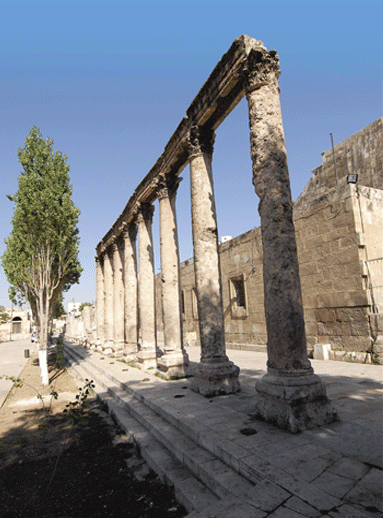
 A trip downtown to see this ancient example of Roman architecture allows you to wonder at the past, stand on the stage and marvel at the clever acoustics, and to observe modern and ancient cultures merge together.
A trip downtown to see this ancient example of Roman architecture allows you to wonder at the past, stand on the stage and marvel at the clever acoustics, and to observe modern and ancient cultures merge together.
The Roman Amphitheatre in
Pillars of Wisdom
Visitors to the Amphitheatre are often struck by its dizzying gradient; it is built into the side of the cliff which was partly cut away to accommodate it.
Amidst the hustle and bustle of a busy day in a thriving city, nestled between a mountain and countless fast - food restaurants, clothes shops, shoe shops and even pet shops, lies a stunning stone marvel that temporarily blocks out the sound of honking taxis and hollering boys. Located in the center of
The Amphitheatre was built under Emperor Antoninus Pius (138-161 AD) when
As you drive through the polluted, overcrowded down-town area on the way to the Amphitheatre, you catch a glimpse of the Nymphaeum, an ornamental fountain, which dates back to 191 AD. Water always played an important role in Roman cities, and the Nymphaeum is dedicated to the water nymphs. History lies everywhere in this town, even quite literally beneath your feet: a Roman water duct channelling a stream between the Nymphaeum and the Amphitheatre is covered by concrete and runs underneath the road. A glance across the street from the Amphitheatre automatically draws up the eye upwards to the Citadel and the
The Citadel Hill tells the story of the various peoples who have inhabited what was once the capital of the Ammonites (BC 1200)  and was mentioned in Deuteronomy in the Bible. Anchored in the slopes of the Citadel Hill are shards of pottery from the Middle Bronze Age, Iron Age, Hellenistic and Roman ages. The Umayyads added to the site with a square and various buildings in the 7th and 8th centuries. Ammon was occupied by the Greeks around 300BC, then by the Ptolemies of Egypt. In the first century BC
and was mentioned in Deuteronomy in the Bible. Anchored in the slopes of the Citadel Hill are shards of pottery from the Middle Bronze Age, Iron Age, Hellenistic and Roman ages. The Umayyads added to the site with a square and various buildings in the 7th and 8th centuries. Ammon was occupied by the Greeks around 300BC, then by the Ptolemies of Egypt. In the first century BC
One can see from photos of the Amphitheatre in the 1930s that
Then,
In the 1930s Prince Abdallah established his office in a house near the Philadelphia Hotel (which no longer exists) across the road from the Amphitheatre. The Department of Antiquities was in a small five-room house adjoining the
 Visitors to the Amphitheatre are often struck by its dizzying gradient; it is built into the side of the cliff which was partly cut away to accommodate it. This unique talent for building on the side of mountains is visible in the homes and buildings surrounding the Roman site. The citizens may no longer be Roman, Greek or Ottoman, but Jordanian master builders and architects carry on building homes on hills and carving apartment blocks into the sides of mountains. A trip downtown to see this ancient example of Roman architecture allows you to wonder at the past, stand on the stage and marvel at the clever acoustics, and to observe modern and ancient cultures merge together seamlessly in one exotic blend of people, noise, traffic, massive stones and an enchanting ambiance in the heart of Amman.
Visitors to the Amphitheatre are often struck by its dizzying gradient; it is built into the side of the cliff which was partly cut away to accommodate it. This unique talent for building on the side of mountains is visible in the homes and buildings surrounding the Roman site. The citizens may no longer be Roman, Greek or Ottoman, but Jordanian master builders and architects carry on building homes on hills and carving apartment blocks into the sides of mountains. A trip downtown to see this ancient example of Roman architecture allows you to wonder at the past, stand on the stage and marvel at the clever acoustics, and to observe modern and ancient cultures merge together seamlessly in one exotic blend of people, noise, traffic, massive stones and an enchanting ambiance in the heart of Amman.